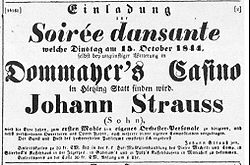
Gunstwerber
Encyclopedia

Opus number
An Opus number , pl. opera and opuses, abbreviated, sing. Op. and pl. Opp. refers to a number generally assigned by composers to an individual composition or set of compositions on publication, to help identify their works...
4, is a waltz
Waltz
The waltz is a ballroom and folk dance in time, performed primarily in closed position.- History :There are several references to a sliding or gliding dance,- a waltz, from the 16th century including the representations of the printer H.S. Beheim...
by Johann Strauss II
Johann Strauss II
Johann Strauss II , also known as Johann Baptist Strauss or Johann Strauss, Jr., the Younger, or the Son , was an Austrian composer of light music, particularly dance music and operettas. He composed over 500 waltzes, polkas, quadrilles, and other types of dance music, as well as several operettas...
.
It was first played on 15 October 1844 at Strauss' début as a composer in Dommayer's Casino in Hietzing
Hietzing
Hietzing is the 13th municipal District of Vienna . It is located west of the central districts, west of Meidling...
, Vienna
Vienna
Vienna is the capital and largest city of the Republic of Austria and one of the nine states of Austria. Vienna is Austria's primary city, with a population of about 1.723 million , and is by far the largest city in Austria, as well as its cultural, economic, and political centre...
, along with several of Strauss' other works, such as the waltz Sinngedichte
Sinngedichte
Sinngedichte , Op. 1, is a waltz composed by Johann Strauss II in 1844 for his debut as a composer at Dommayer's Casino in Vienna. The waltz was played along with several other compositions that Strauss had written for the occasion, such as the waltz Gunstwerber and the polka Herzenslust...
and the polka
Polka
The polka is a Central European dance and also a genre of dance music familiar throughout Europe and the Americas. It originated in the middle of the 19th century in Bohemia...
Herzenslust
Herzenslust
Herzenslust , Op. 3, is a polka composed by Johann Strauss II in the fall of 1844 for his debut as a composer at the Dommayer's Casino establishment in Vienna. It was performed along with several of Strauss' other early compositions, such as the waltzes Sinngedichte and Gunstwerber, and the...
. The music critic Ernst Décsey
Ernst Décsey
Professor Dr. Ernst Décsey, born Ernst Deutsch , was an Austrian author and music critic.Décsey was born in Hamburg and studied law at the Vienna University...
commented on Strauss' waltz: "As if singing had broken out from all three storeys of the house [...] the same charm, the same modest piano, the same reverberating forte as the father. Basses rumble, intermediate parts woo, and the main violin theme vibrates across to the ladies."

